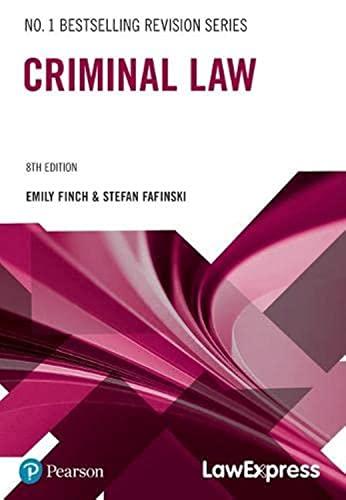Question
1. The separation of powers in the legal system is to ensure that power does not solely rely on each branch to creating law for
1.The separation of powers in the legal system is to ensure that power does not solely rely on each branch to creating law for the whole framework.
| a. | True |
| b. | False |
2. Private law is usually seen with lawsuits?
| a. | True |
| b. | False |
3. An "Act" is a form of statutory law
| a. | True |
| b. | False |
4. Regulations are made first before an Act is created
| a. | True |
| b. | False |
5. An Act is legislation which can be easily modified
| a. | True |
| b. | False |
6. In private law there needs to be ___% proof/certainty established as the balance of probability to make judgement
7.In criminal and regulatory law there needs to be __% proof/certainty established as the standard of proof
8.In criminal law, ________ is required in order to determine one has truly committed a crime.
9. Non-federal workplaces would follow _______OHS laws respective to their ______
10. A decision or judgement of court of law which is cited as the authority for deciding a similar situation in the same manner/principle/ or analogy is called?
| a. | Retroactive law |
| b. | Precedent |
| c. | Common sense |
| d | Law and order |
11.A person who has a legal matter between themselves and the government would be ruled by:
| a. | Public law |
| b. | Private law |
| c. | Tort law |
| d | Case law |
12. Before an Act is passed it first starts off as a:
| a. | Decision |
| b. | Bill |
| c. | Idea |
| d | Regulation |
13. Regulations are created in the
| a. | Cabinet |
| b. | Legislature |
| c. | Courts |
| d | Streets |
14.The first area which is cited when reading a paragraph within an act or regulation is called:
| a. | Source |
| b. | Preamble |
| c. | Section |
| d | Citation |
15.The legislation which governs federal workplaces is called:
| a. | Canada Criminal Code |
| b. | Canada Common Law |
| c. | Canada Labour Code |
| d | Canada Case Law |
16. A bill is read ____ times before getting signed by Lt Governor:
| a. | 1 |
| b. | 2 |
| c. | 3 |
| d | 4 |
17. What the Workplace Safety and Insurance Act previously called before 1997:
| a. | Worker's Insurance Act |
| b. | Workplace Insurance Act |
| c. | Workplace Compensation Act |
| d | Workers Compensation Act |
18. Up to how long can a claim be filed after its occurrence to the WSIB after an employee suffers from an illness related to their work.
| a. | 3 months |
| b. | 4 months |
| c. | 6 months |
| d | 12 months |
19. Before what time limit must the employer file a Form 7 once they become aware of an accident-causing injury to worker.
| a. | 2 days |
| b. | 3 days |
| c. | 4 days |
| d | 5 days |
20. The Westray Mine Disaster in 1992 brought forward the creation of what Bill in Canada.
| a. | Bill C-92 |
| b. | Bill C-25 |
| c. | Bill C-45 |
| d | Bill C-50 |
21.What is an 'Act of God. (2 marks)
22. Briefly explain the difference between the Occupational Health & Safety Act and the Workplace Safety & Insurance Act. (6 marks)
23. What does WSIB stand for and what does it do. (4 marks)
24.Identify and briefly explain what are the institutional "branches" of the legal system - "separation of powers" in Canada. (6 marks)
25. Identify and briefly explain what the types of law used in the Canadian legal system are. (12 marks)
26. Identify and briefly explain 3 types of benefits and services available for employees injured while at work. (6 marks)27. What is the difference between Trespass and Nuisance. (4 marks)
28.Briefly explain under what circumstances a joint health representative is required. (2 marks)
29.Under what circumstances can an employee refuse work. Briefly describe the work refusal process. (5 marks)
Step by Step Solution
There are 3 Steps involved in it
Step: 1

Get Instant Access to Expert-Tailored Solutions
See step-by-step solutions with expert insights and AI powered tools for academic success
Step: 2

Step: 3

Ace Your Homework with AI
Get the answers you need in no time with our AI-driven, step-by-step assistance
Get Started


